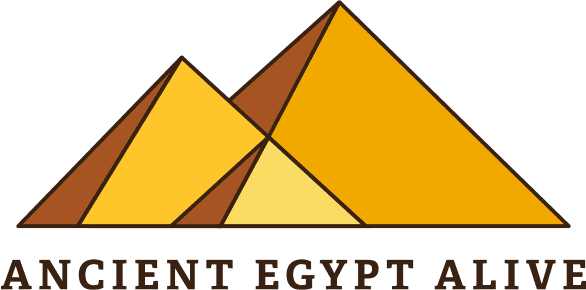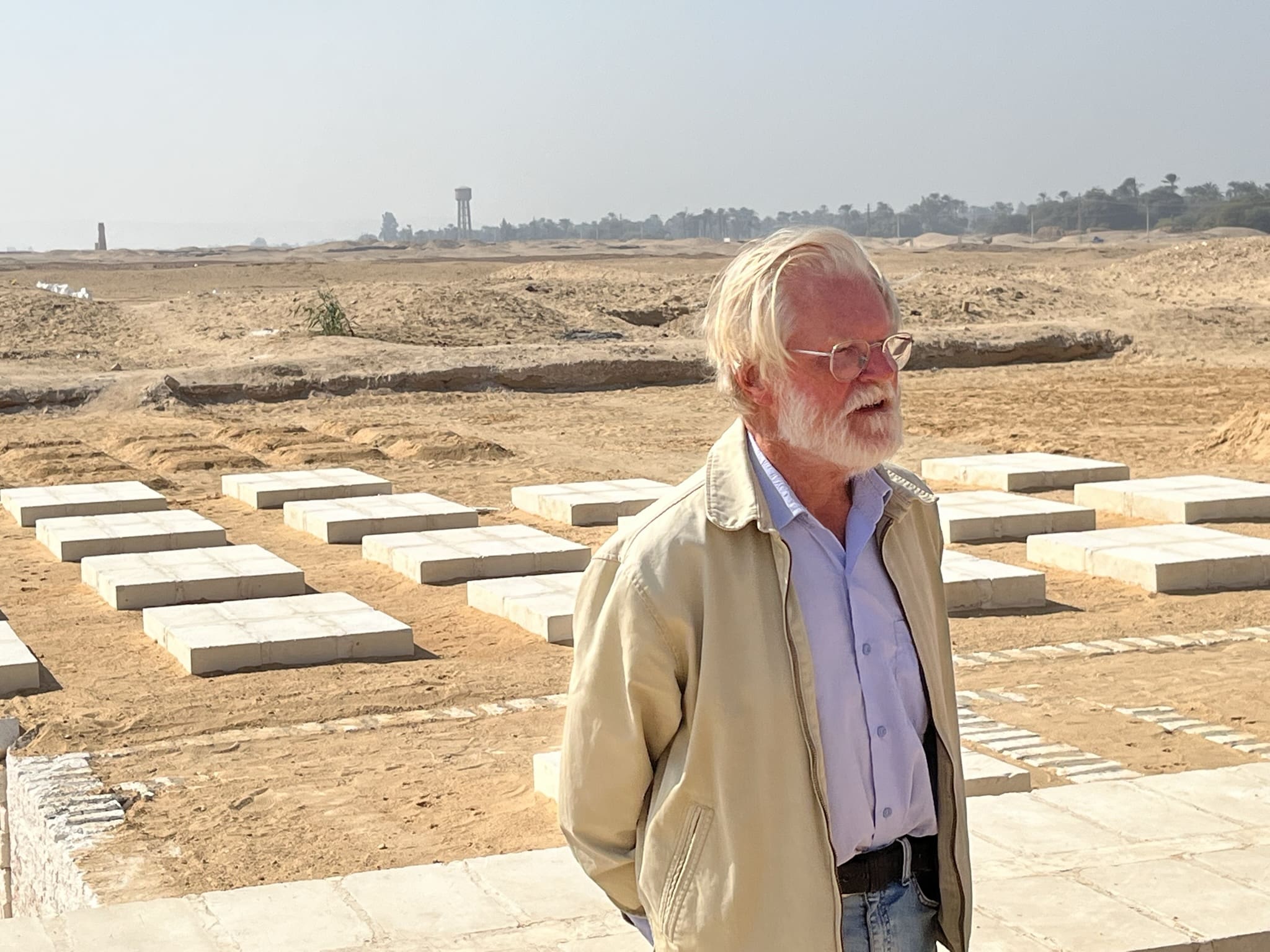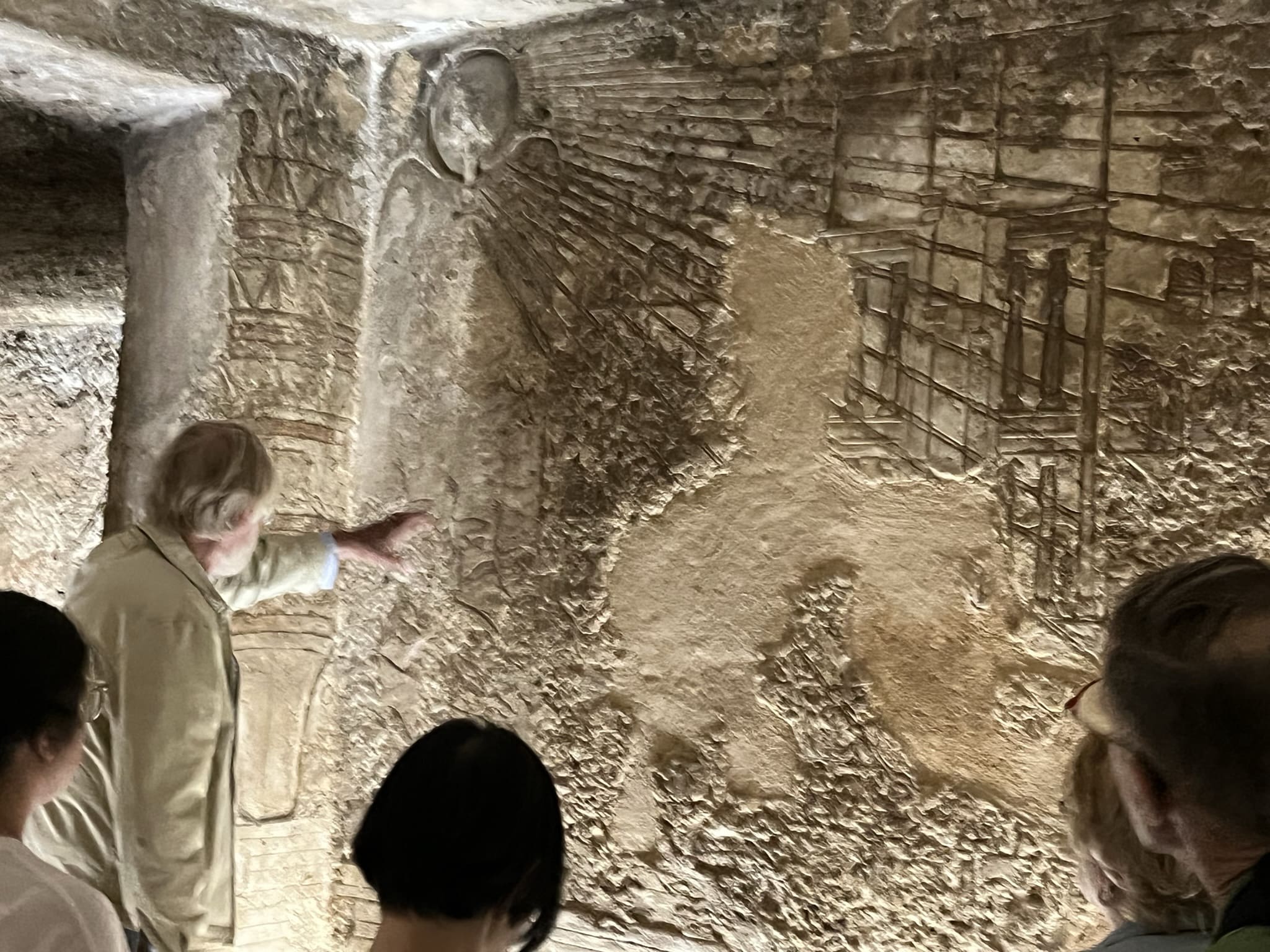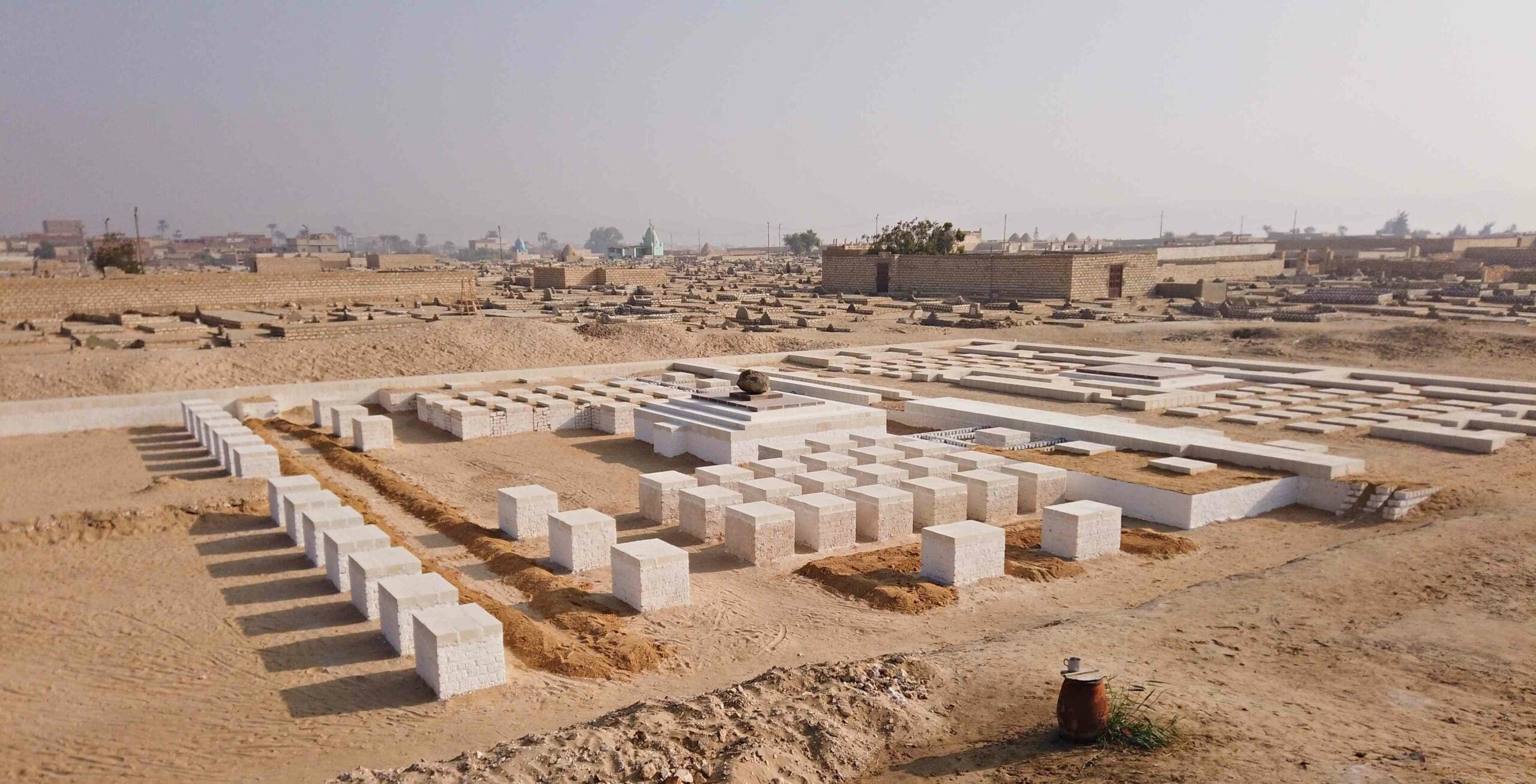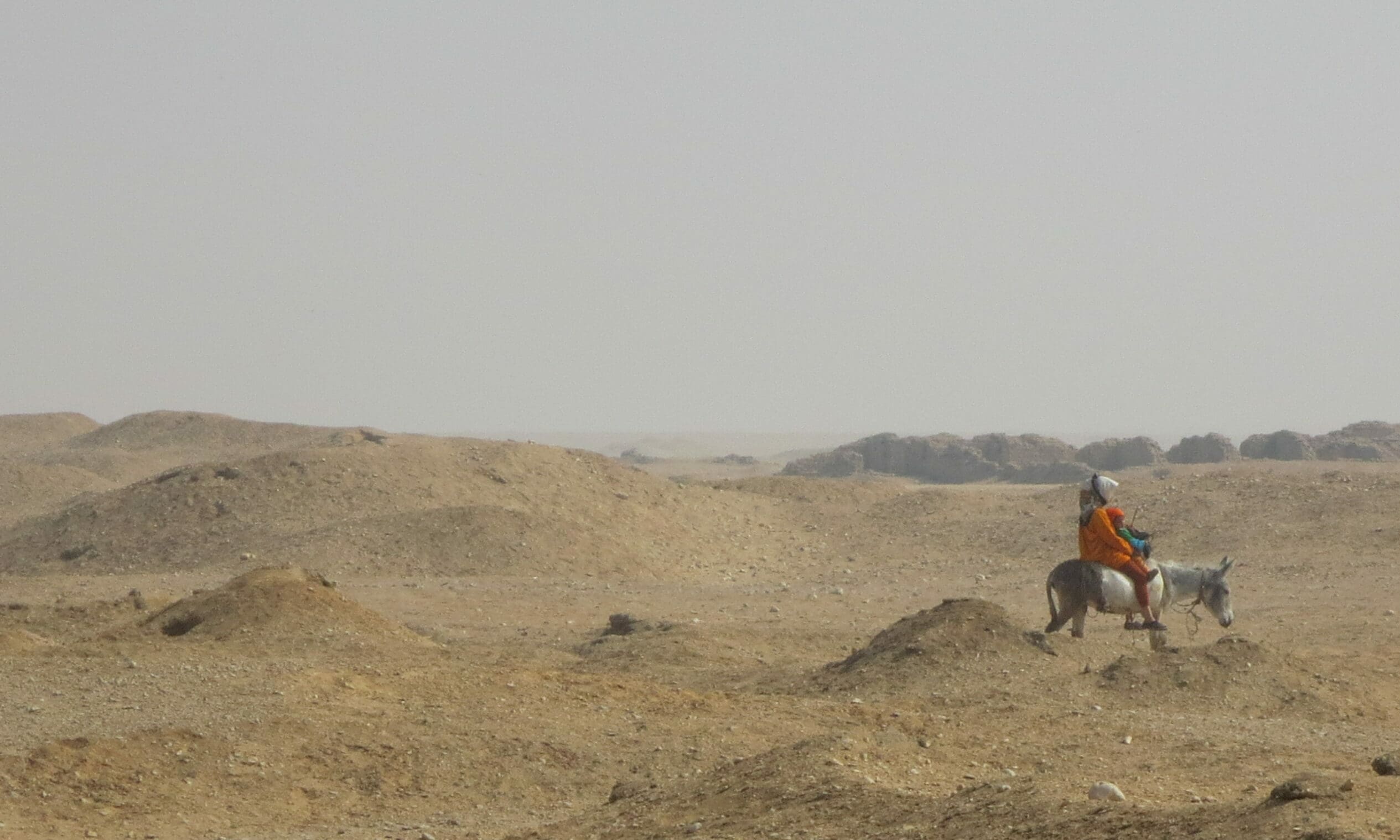By Laura Ranieri Roy (All photos except one noted. c. Laura Ranieri Roy)
It was ten years ago last February that I escaped wintry Toronto and flew to Egypt – to lend an ‘amateur’ hand to the new excavation and restoration project at Akhenaten’s great temple of Aten.
Much exciting work has transpired at the Great Aten Temple site in a decade! I was fortunate enough to make a return visit with a tour group in November 2022.
Professor Barry Kemp generously toured us around the site – bounding up steps and inclines with the agility of a 30-something. We got a rare look at progress on the Great Temple with all its offering tables – and also a special tour of the Small Aten Temple, the North Palace, and, of course, the spectacularly decorated North Tombs and spooky Royal Tomb of Akhenaten as well.
During this past 2023 season, accomplishments abound at the Great Aten Temple – and many important new insights too. According to archaeologist Miriam Bertram, the completion of 40 offering tables and two central platforms were a big highlight. In antiquity, thousands of these offering tables stood at the temple (a mark of Akhenaten’s religious zeal around his new Aten religion). Can you imagine the heaps of food placed at all these tables, fermenting in the midday sun? Luckily, Kemp and team are fairly confident that Amarna residents, rich and poor, were indeed invited to partake in the feasting in and around the temple on occasion. Let’s hope all those fresh offerings were not wasted!
The goal of the current restoration is not to completely rebuild the temple, but rather to give visitor an idea of how this unique sacred site may have looked – while protecting the site from the encroaching village of El Til and its cemetery. Also, of course, to piece together more insights into this most fascinating period of Egyptian history during and after the reign of Akhenaten. One of the most interesting things Professor Kemp mentioned to us during our 2022 visit was this: while vestiges of Akhenaten and Nefertiti were obliterated from the site, the Aten name, in some areas remained. Does this mean worship of the Aten continued for a few decades AFTER the great restoration under Tutankhamun, Aye and Horemheb? Interesting indeed.
Now… I am pleased to share my special article detailing my own 2013 experience assisting with excavations at the site originally published on the Royal Ontario Museum website.
Restoring a Rebel Pharaoh’s Kingdom
Tell el Amarna is a remote desert outpost in the centre of Egypt between Cairo and Luxor on the east bank of the River Nile. Arriving here is like landing on the moon – a desolate and vast expanse of hills and red, cratered sand. There is little human settlement for miles, save a few scattered villages.
Bleak Amarna view from just north of the Kemp dig house looking east to the mountains
Well over three millennia ago, it was the centre of a great kingdom, a unique capital city teeming with pig farmers and priests, glassblowers and sculptors, and presided over by one of the most notorious pharaohs in ancient history: Akhenaten, the idealistic and reviled heretic king who had been called to the site by a greater power—his sun god Aten. Over a span of just 15 years, Akhenaten built strange, roofless temples, launched a bold new religion, battled a disease epidemic, and eccentrically ruled over all of Egypt from his extraordinary sun city. And then it was gone.
Rare Akhenaten and Nefertiti relief from the Northern rock cut tombs
Fast-forward 3,500 years – February 2013 –and… here I was for the experience of a lifetime. The chance to join for just a brief two weeks a small archaeology team led by one the greatest living archaeologists, Prof. Barry Kemp CBE of Cambridge University in England. He and his team were in the second season of excavating and partially reconstructing Akhenaten’s Great Temple of Aten. The city lasted less than two decades, but Kemp, now in his 70s, has been working here for 35 years! One of the tasks was piecing together and dating the different layers, as the temple was rebuilt several times.
Arrival at the historic dig house
Upon first arriving at the dig house, I was led through a swinging door and there was Prof. Kemp, seated at the rustic dining table, white hair brushed back and sun burnt face. He looked to me like a mature Lawrence of Arabia — the very image of a veteran, distinguished archaeologist. In his warm yet understated British way, he welcomed me, and I joined the small group of four archaeologists for a generous feast of pasta, beans, fish and bread pudding.
The Amarna dig house – originally built by Borchardt’s team, the 1910s – on an ancient Amarna house.
The cheery dig house was a haven of comfort and conviviality against the bleak terrain and poor villages of modern Tell el Amarna. It is a historic site in its own right, the former headquarters of Ludwig Borchardt – the renowned German archaeologist who 100 years ago found the famous Nefertiti bust near here. Even more fascinating, the residence was built upon one of the original Amarna houses dating back 3,500 years. It is a place imbued both modern warmth and ancient magic!
Day One at the Sun Temple
My alarm went off at 5:30 am, and after a hearty breakfast, we all loaded the truck with materials and equipment and piled into the back for the 5-minute standing ride to the Great Aten temple.

Windblown on the truck a few minutes from dig house to temple very very early morning when Aten breaks on the horizon
What a thrill to be here. Akhenaten’s great temple is one of the most important sites of Amarna. This once fantastic roofless structure, with many buildings, chapels, ceremonial gates, slaughterhouses and more than 900 eerie offering tables, had been fully demolished in antiquity. Finally it would rise again — at least in part.
Views of the Great Temple of Aten dig site
My first job was at the front of the temple, joining a team of workers excavating a massive “rubbish pile” at the first pylon, rich with artifacts discarded by John Pendlebury’s dig in the 1930s. A group of local workers headed by the gentle Mustafa started teaching me the Arabic words for trowel, shovel and brush as we sifted through the sand, 5 centimetres at a time.
Prof. Kemp came by to inquire how I was doing and remarked offhandedly: “With any luck, we should find remains of half of a sphinx somewhere here. Pendlebury found part of it, which is now in a British museum. But in reality, it is likely smashed unrecognizably into pieces.” We did find some great pieces that day, even with paint. But perhaps the find of the morning was part of a wine jug or ostraca discovered back in the temple inscribed with the word “wine of the house of the Aten” “This is quite useful,” said Professor Kemp. “It implies this area was built after year 12.”
Mustafa and I (Laura) make a find in Pendlebury’s rubbish pile.
Workers at the Great Temple of Aten
The wonderful therapy of digging
Digging in the ancient sand in the hot sun is very therapeutic. There is a smell of chalk in the air, mixed with the tobacco smoke of Mustafa beside me and the Sufi music playing on Hamada’s little radio. There is a constant procession past the site of wagons, tuktuks, rusty bicycles and water buffalo laden with oranges, alfalfa and other goods. I was slowly getting more of a sense of the ancient temple and also of the modern community surrounding it. Many of the workers were from the communities of Hagg Quandil and El Till – conservative Muslim villages built up around strong families. The cemetery of El Till was actually encroaching on the Great Temple – and only recently, lines were (literally) being drawn in the sand.
Local farmers along the Amarna roads (yes, cell phones are big in Amarna – I am sure he is on FB too).
As I worked, I pondered why I was so drawn to sift sand in search of the past. Perhaps it is simply reassuring to connect with the ancient, seeking a sense of the continuity of human life that can be quite comforting in its way. And to connect with the strange Amarna past in Egypt was to travel back to a time that was so glamorous, ceremonial and dramatic, compared to our clean and sterile technology-driven world.
I am sure that Prof. Kemp must also feel a similar comfort and kinship with ancient Amarna somehow, though I did not ask him. He was a quiet, self-effacing and modest man on site and around the dig house, supervising the grocery selection and typing away in his little office in the back. Personally caring for his team and the Amarna people who supported the expedition seemed to be as important to him, in many respects, as his archaeology work.
Kemp surveying the temple site, facing east, March 2013
Me (Laura) after a“second breakfast” of fool and tamaya sandwiches on site in the archaeology tent.
Ancient and modern worlds of Amarna
Into my second week, we were making progress removing ‘Pendlebury’s dump’ to reveal the mud bricks of the first pylon. To the north of us, Anna, a young British archaeologist, was working on the entrance gate, while to the east Sue Kelly from Canada was drawing some curious basins she had revealed. Prof. Kemp was focused on the project of the first court, a great excavated slab that had been entirely dug around. There were traces of where columns have stood. And of course, he was overseeing the workers rebuilding the bases of some columns just after the first pylon – just enough to show people how they would have appeared and to give a sense of the temple.
Tomb Tripping
By far, the most spectacular Amarna sites to visit are the rock cut tombs high up in the surrounding hills. On my day off, guided by a driver and some information binders I went to see them, beginning with the Royal Tomb of Akhenaten, hidden in a distant sand-blown valley where supposedly the sun rises each morning at dawn through the cliffs. From the curving path high above the desert along the ridge of the mountains you can see the Nile and the crescent stretch of the ancient city below. The soundtrack is the braying donkeys against the sound of the call to prayer — an enchanting, otherworldly melange. A lone red fox scampered across the crumbling cliff face as I stood and listened.
This is where you can see some of the most stunning art in all of ancient Egypt: vibrant dancing horses, swaying musicians, and of course Akhenaten and Nefertiti with elongated faces and round hips, touched by the spidery hands of the Aten’s rays.
When we reached the generator to turn on the lighting in this tomb, it wasn’t working. Still, my local escorts were keen that I visit lights or no – and so they enthusiastically led me inside in utter darkness. With the help of my camera flash we made our way cautiously through the two main chambers, grasping hands so we would not trip in the blackness. It was certainly bizarre, but once my camera flashed, there in front of our eyes were the striking wall paintings of
The king, the queen and their Aten.
My guides struggle to provide light with their cell phones in the darkness of the Royal Tomb of Akhenaten
The other rock-cut tombs to the north were magnificent – and fully lit. The tomb of Meryre, high priest of the Aten, held especially wondrous scenes: blind beggars awaiting alms, bowing and scraping attendants and a vivid animal slaughter court. The centerpiece is a finely preserved scene of Akhenaten’s horse and chariot with its deep red paint still vibrant.
Me in the tomb of Aye (southern rock cut tombs)
Forbidden flight through the ghost town of Akhetaten.
On my final day I began an adventurous excursion: My plan was to walk – not ride – to the Great Aten Temple site. It was a tad controversial as local police escorts are de rigueur throughout Middle Egypt.
A vast stretch of gently rolling desert land stretched out before me on that hazy morning. I could hardly see any landmark columns but headed roughly northward toward the site. In reality, I was walking through a ghost town. This was the central city of Akhetaten, and the mounds I was traversing and circumnavigating were in fact the ancient houses and buildings of Akhenaten’s metropolis from back in 1353 BCE. What particularly struck me were the piles upon piles of pottery sherds – all remnants from that ancient city.
For the first half of my journey, I was alone. Then I climbed over a large mound and saw a small pack of wild dogs that alarmed me. I remembered someone telling me that if I just picked up a rock they would go away. I did so, took another route and thankfully lost them.
The vast sand dunes and ancient city ruins passed during my walk to the dig site.
Farewell to sun city
On my final afternoon back at the dig, many of the ancient mud bricks of the first pylon were finally at the surface. Our work was interrupted, however, by a funeral in the El Till cemetery next door. There was a solemn Muslim procession. We broke from our dusty work to stand in tribute as men in black carried a coffin down the dusty road, probably much as they had done long ago in Akhenaten’s time.
My Amarna journey was coming to a close. I had come in search of Akhenaten and ancient history – but found myself immersed in modern village life and the rough but warm people of the region today. I had found meditative moments digging in the sand and dust – far from sterile city life. And I discovered the togetherness and challenges of community living—along, of course with the surprising modesty and decency of Prof. Barry Kemp, one of the great archaeologists of our time.
Lead archaeologist Miriam Bertram and workers 2013
Glorious sunset over Hagg Qandil – from the roof of the Amarna dig house
All photos c. of Laura Ranieri Roy 2013 and 2022
—————————————–
Would you love to be part of the Great Aten Temple for eternity? Don’t miss a chance to donate to the Aten Blocks fundraising program – starting at just 7 euros! Learn more here
Don’t Miss Professor Barry Kemp’s new Ancient Cities lecture on Sunday November 12, 2023 – all monies go to the Great Aten Temple project
<register here>
